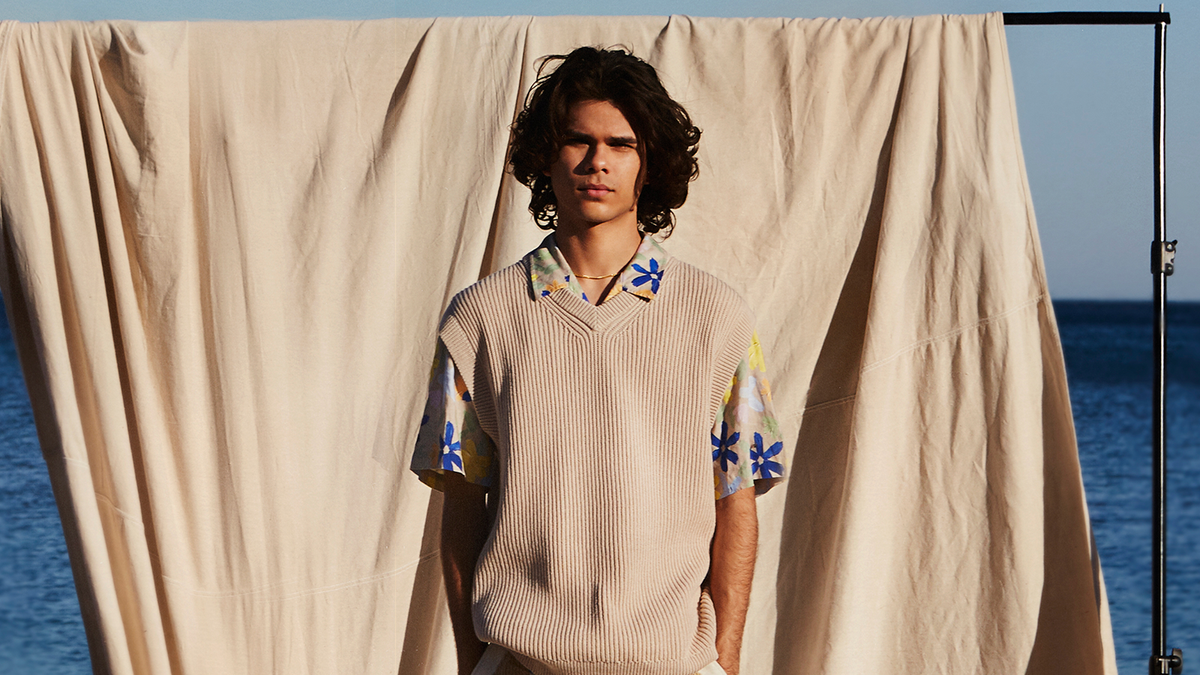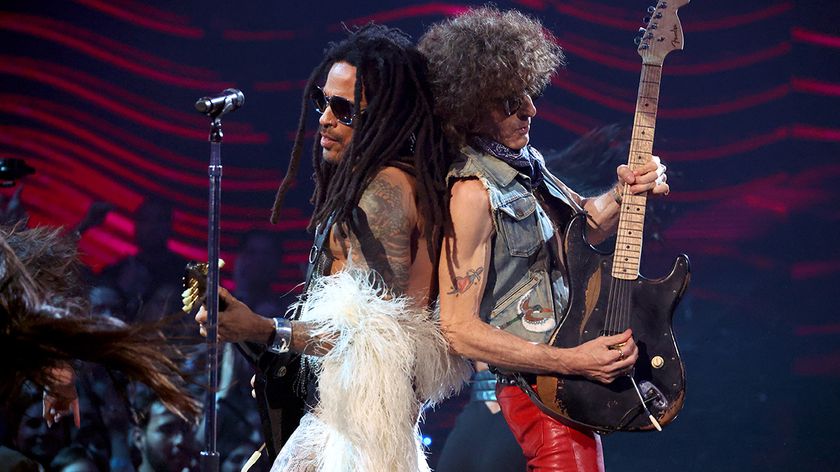Budjerah: “If I didn’t know where I was going, I think I’d go crazy”
Budjerah fills us in on his striking new EP Conversations, and the strong ties between his art and heritage.

Fame struck Budjerah like a truck: the Coodjinburra songster dropped his eponymous debut EP last March, and by the year’s end had become a national sensation with truckloads of records sold, opening spots on tours with acts like Thelma Plum, The Avalanches and Lime Cordiale, a god-tier collab with EDM megastars Pnau, and wins at both the ARIAs (Breakthrough Artist) and National Indigenous Music Awards (New Artist Of The Year). But despite his sudden thrusting into the mainstream, Budjerah has remained resoundingly humble.
When he jumps on a Zoom call with Australian Guitar, the 19-year-old is brushing off crumbs from a sausage roll he snagged from his favourite local bakery. He still lives in the coastal NSW town of Fingal Head, with strong ties to his community in the Bundjalung nation. His scintillating second EP, Conversations, offers fans a more intimate look behind the curtain: it lays Budjerah’s soul bare, each line intensely impactful and each accompanying soundscape – built up of glittering synths, cool atmospherics, crisp beats and the warm strums of his guitar – even more so.
Budjerah’s go-to guitar is a Fender Acoustasonic Stratocaster, special to him not just because of its wicked playability, masterful design and sweet, sweet tone. At the start of February, his management team secretly teamed up with Fender Australia to have a custom axe whipped up, featuring artwork minted by Budjerah’s uncle. We chatted with Budjerah about that guitar, Conversations, and how his family and art are always going to be intrinsically linked.
How did you want this EP to build on what you’d laid out with your self-titled record?
I know we should probably be talking about how the guitar, but I’ve always viewed myself more as a singer. So with the first EP I was like, “Yeah, I’m gonna have these massive intervals between the chorus and the verses, and I’m just going to sing my butt off!” But a lot of the time, when people heard me sing the songs, they were like, “Oh, I didn’t really think much of you as a singer.” I would sing my songs, and then I’d sing like an old soul song, or a gospel song, and they’d be like, “Wow, you’re actually a singer!” So with this EP, I was like, “I just need to sing harder, so then people will go ‘Yeah, he’s a great singer!’”
When it comes to what kind of sounds you feel like jamming out, does it all come down to the vibe you’re in?
Yeah, it definitely depends. I’ve been wanting to write more upbeat songs, but I think with my writing process, it’s sort of whatever music I’m hearing around me, I’ll write to match that. And normally, whatever comes out in the lyrics is just an emotional dump – it’s just me letting out whatever has been going on in my head. If you listen to [‘What Should I Do?’], it’s very literal. Everything in that song actually happened to me, and the production was just super... It’s upbeat and funky, but when you listen to the lyrics, you’re like, “Oh wow, that doesn’t sound too good. That sounds like he had a real hard time”. The music just brings it out, I think.
As for the gear, the big ticket item here is, of course, this incredible Acoustasonic Strat that features your uncle’s artwork. What was going through your head when you saw that for the first time?
We were shooting a music video, and one of my managers brought it to the shoot. Heath [Blows] from Fender, he sent me my other Acoustasonic, and he was like, “Yeah, we’ll send you another guitar before you go on tour.” I thought I was just going to get a regular Strat, because I’ve wanted to get more into playing an actual electric guitar. But the box showed up to the shoot and they were like, “Yeah, we got this thing from Fender.”
I recognised the case because it was the case that my other Acoustasonic came in, and I was like, “Wait, why did they send me another Acoustasonic? I’ve already got one!” My mum was there, and she was like, “Just open it!” It was such a surprise. After the ARIAs, my team were all like, “Yeah, let’s do something real cool, let’s get the artwork to match the CD cover,” and... I just love it.
Get The Pick Newsletter
All the latest guitar news, interviews, lessons, reviews, deals and more, direct to your inbox!
The artwork tells the story of my background. Budjerah means ‘first light’, because I was born as the sun rose in the morning; and if you look at the artwork, there’s a big circle just above the sound hole – that’s the Morning Star, which is the last star to leave the sky in the morning. And then there’s The Three Brothers: in Bundjalung, all the tribes come from The Three Brothers, that’s like the start of the story for Bundjalung nation. So it’s really special, to see all those things represented in the artwork.
How important is it for you to stay connected to your community and culture?
It’s very important. I still live in the community I grew up in – if I walk next next door, all of my grandparents and uncles and my family are all there. We’re very lucky to still have our language, and our dances, and all of our traditions intact, so it’s very important to me to embrace that. And just knowing who you are is so important – it keeps you sane, I think. If I didn’t know where I was going, or if I didn’t have a place I could go back to, I think I’d just go crazy. I know I can always come back home to my family and to the place where I belong.
Have you and your uncle always bonded over your artistic similarities?
He’s a guitarist as well. Maybe I’m a bit biased, but in my eyes, he’s one of the greatest guitarists I’ve ever heard. He did the artwork for my first CD, and he actually played on a few of the tracks, too. He was at the studio, and while I was recording vocals, we were like, “What could we do with this?” We were doing a limited edition CD version of [the self-titled EP], and I asked him, “Do you want to do the artwork?” And he just brought along a little canvas and painted the artwork.
If you walk next door, there’s paintings of his everywhere. They’re all done in that same style; there’s one for my name, and he’s done my cousin’s name, and it’s all just representative of, like, our stories and our culture’s stories. It’s just incredible. He’s started painting all of this incredible artwork in the last year or so, I reckon.
What was it like to have him there with you in the studio?
It’s really good. It’s just fun. My dad is a drummer as well; my dad and his brothers, they’re all musicians, and they played in the church band with my mum and all of her siblings. So my dad and my uncle, they came along played all the instruments on, like, four extra tracks [for the self-titled EP]. We were all just jamming. They knew the songs, and it was really easy because they both know exactly what we wanted. We were all just on the same page

Ellie Robinson is an Australian writer, editor and dog enthusiast with a keen ear for pop-rock and a keen tongue for actual Pop Rocks. Her bylines include music rag staples like NME, BLUNT, Mixdown and, of course, Australian Guitar (where she also serves as Editor-at-Large), but also less expected fare like TV Soap and Snowboarding Australia. Her go-to guitar is a Fender Player Tele, which, controversially, she only picked up after she'd joined the team at Australian Guitar. Before then, Ellie was a keyboardist – thankfully, the AG crew helped her see the light…
- Ellie RobinsonEditor-at-Large, Australian Guitar Magazine

“We had 15 minutes left, and it was time to go… I just started playing that riff. Then Lenny goes, ‘Whoa, what’s that?’” Lenny Kravitz guitarist Craig Ross reveals the serendipitous roots of a Kravitz classic

“The concept of the guitar duel at the end was just appalling”: Crossroads is an essential piece of '80s guitar lore, but not every guitar legend was a fan of the film








